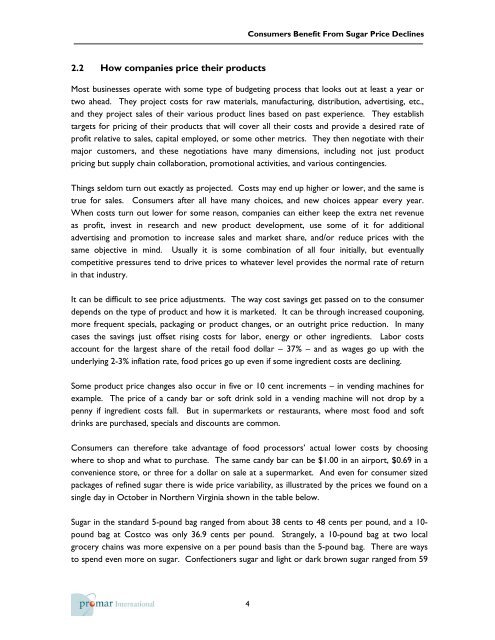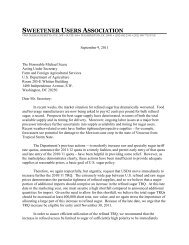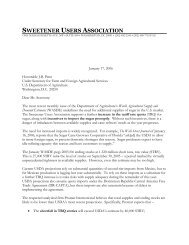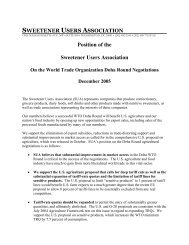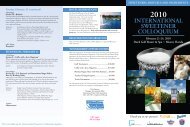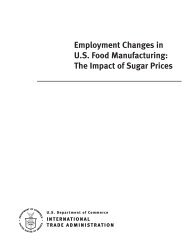Consumers Benefit From Competitive Sugar Prices - Sweetener ...
Consumers Benefit From Competitive Sugar Prices - Sweetener ...
Consumers Benefit From Competitive Sugar Prices - Sweetener ...
You also want an ePaper? Increase the reach of your titles
YUMPU automatically turns print PDFs into web optimized ePapers that Google loves.
<strong>Consumers</strong> <strong>Benefit</strong> <strong>From</strong> <strong>Sugar</strong> Price Declines2.2 How companies price their productsMost businesses operate with some type of budgeting process that looks out at least a year ortwo ahead. They project costs for raw materials, manufacturing, distribution, advertising, etc.,and they project sales of their various product lines based on past experience. They establishtargets for pricing of their products that will cover all their costs and provide a desired rate ofprofit relative to sales, capital employed, or some other metrics. They then negotiate with theirmajor customers, and these negotiations have many dimensions, including not just productpricing but supply chain collaboration, promotional activities, and various contingencies.Things seldom turn out exactly as projected. Costs may end up higher or lower, and the same istrue for sales. <strong>Consumers</strong> after all have many choices, and new choices appear every year.When costs turn out lower for some reason, companies can either keep the extra net revenueas profit, invest in research and new product development, use some of it for additionaladvertising and promotion to increase sales and market share, and/or reduce prices with thesame objective in mind. Usually it is some combination of all four initially, but eventuallycompetitive pressures tend to drive prices to whatever level provides the normal rate of returnin that industry.It can be difficult to see price adjustments. The way cost savings get passed on to the consumerdepends on the type of product and how it is marketed. It can be through increased couponing,more frequent specials, packaging or product changes, or an outright price reduction. In manycases the savings just offset rising costs for labor, energy or other ingredients. Labor costsaccount for the largest share of the retail food dollar – 37% – and as wages go up with theunderlying 2-3% inflation rate, food prices go up even if some ingredient costs are declining.Some product price changes also occur in five or 10 cent increments – in vending machines forexample. The price of a candy bar or soft drink sold in a vending machine will not drop by apenny if ingredient costs fall. But in supermarkets or restaurants, where most food and softdrinks are purchased, specials and discounts are common.<strong>Consumers</strong> can therefore take advantage of food processors’ actual lower costs by choosingwhere to shop and what to purchase. The same candy bar can be $1.00 in an airport, $0.69 in aconvenience store, or three for a dollar on sale at a supermarket. And even for consumer sizedpackages of refined sugar there is wide price variability, as illustrated by the prices we found on asingle day in October in Northern Virginia shown in the table below.<strong>Sugar</strong> in the standard 5-pound bag ranged from about 38 cents to 48 cents per pound, and a 10-pound bag at Costco was only 36.9 cents per pound. Strangely, a 10-pound bag at two localgrocery chains was more expensive on a per pound basis than the 5-pound bag. There are waysto spend even more on sugar. Confectioners sugar and light or dark brown sugar ranged from 594


